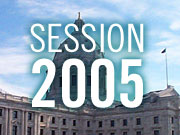Audio
Photos
More from MPR
Resources
Respond to this story
| |||||||||||||||||||||||||||||||||||||
Does Minnesota spend too much?
December 13, 2004
 |
| Gov. Tim Pawlenty is holding fast to his no-tax-increase position, as he prepares a state budget to cover a $700 million deficit. (MPR file photo) |
St. Paul, Minn. — On the same day finance officials projected the $700 million shortfall, Gov. Pawlenty was prepared with an eye-opener of his own -- state general fund spending has more than doubled since 1990. That, says Pawlenty, is convincing evidence that the appetite for new dollars is out of control.
"I think the bulk of Minnesotans would say that state government probably shouldn't grow more than the private sector economy is growing, or more than inflation or a little more than inflation," Pawlenty said. "I think that's a reasonable goal."
But Wayne Cox says the state has more than met that "reasonable goal." Cox represents Minnesota Citizens for Tax Justice, a group backed by union interests. He says if all revenues collected at the state, local, and school district level are added up and expressed as a percentage of Minnesota personal income, the cost of government has actually fallen -- and dramatically.
The "price of government" index measures spending against the taxpayers' ability to pay. Cox says, in that respect, government has become less burdensome.
|
Most states are in the same boat as Minnesota. The revenue seems to be coming in pretty good. The problem is on the expenditure side (because of rising health care costs).
- Scott Pattison, National Association of State Budget Officers |
"The size of the economy tells you what is your capacity in the state," said Cox. "Government's share of our economy has been in decline in Minnesota. So it certainly isn't usurping resources unduly."
The price of government index hit a recent high of 17.9 percent of personal income in 1994, and has tapered off since, according to state Finance Department figures. By 2009, it's expected to be close to 15 percent. In fact, if the entire deficit were eliminated through tax increases, the price of government would still be below 1990 levels.
But Taxpayers League executive director David Strom says just because Minnesotans can pay for more government, doesn't mean they should.
"This idea that government should have some set slice of your income, I think, is just ridiculous," Strom said. "It relieves the pressure on government to actually produce the goods and services that it produces in any kind of efficient way."
The Taxpayers League offered up the no-new-taxes pledge signed by the governor and others in 2002, and Strom says Pawlenty is correct to continue honoring it. He notes that in comparison to the rest of the nation, Minnesota remains a high-tax state.
Data from New York's Rockefeller Institute of Government indicate that in 2000, Minnesota's price of government index was 11 percent above the national average. Measured on a per-capita basis, Minnesota's spending was 20 percent above the national average.
Those figures have likely declined following rounds of Minnesota tax cuts enacted in the last few years. But the institute's director of fiscal studies, Don Boyd, says Minnesota remains a high-tax, high-service state. He says that doesn't necessarily reflect poor public stewardship.
"It might come from greater preference for public services," said Boyd. "It might come from greater desire to provide, for example, health care for the needy and, of course, greater capacity to afford services. So you can't conclude from those kinds of numbers that somebody's somehow too high or too low."
Boyd and others acknowledge, however, that the current budget strain is mainly the result of fast-growing spending in health and human services. In Minnesota, that portion of the budget is expected to jump 20 percent in the next two years if adjustments aren't made. Scott Pattison of the National Association of State Budget Officers says therein lies the problem.
"Most states are in the same boat as Minnesota," said Pattison. "The revenue seems to be coming in pretty good. The problem is on the expenditure side. There are some fairly hefty growth rates in health care and the Medicaid program that states have to spend money on."
But Pattison, too, says there's no obvious solution. States can raise taxes, hoping to stay abreast, or they can reduce services and trim eligibility for state assistance, or both. Pattison and Boyd say that's a political issue. The data may define the problem. As for a solution, the data are frustratingly mute.
|
News Headlines
|
Related Subjects
|

